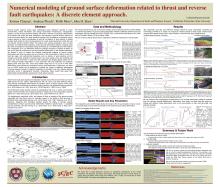Numerical modeling of ground surface deformation related to thrust and reverse fault earthquakes: A discrete element approach
Kristen Chiama, Andreas Plesch, Robb Moss, & John H. ShawSubmitted September 11, 2022, SCEC Contribution #12536, 2022 SCEC Annual Meeting Poster #120 (PDF)
Ground surface ruptures during large earthquakes pose significant hazards to urban environments, critical information and energy transmission infrastructure, transportation systems, as well as other sensitive facilities. We seek to improve our physical understanding of the factors that control the style, distribution, and intensity of ground surface ruptures on thrust and reverse faults. Our study combines insights from the patterns of coseismic ground surface ruptures in historic earthquakes as well as the patterns of fault ruptures in analog sandbox fault models to inform the development of a suite of geomechanical models that use the discrete element method (DEM). We explore how various parameters, such as fault geometry and sediment/soil properties, control ground deformation patterns including scarp dip, width, and patterns of secondary folding and fracturing. The DEM method is well suited to this investigation as it can effectively model the geologic processes of faulting at depth, as well as the granular mechanics of soil and sediment deformation in the shallow subsurface. We discuss a suite of models that illustrate characteristic patterns of ground surface deformation and show how these vary as a function of the accumulation of slip on a fault, the fault dip angle, and sediment/soil properties such as density of grain packing and the cohesion and tensile strength of particle bonds. Our initial results show that localized fault scarps are most prominent in cases with stiff sediments and steeply dipping faults (40º to 60º), whereas broader deformation is more prominent with soft sediments and shallowly dipping faults (less than 30º). Fault scarp widths range from 2.0 m to 20 m with wider deformation zones defined by secondary fractures and backthrusts. Furthermore, we show how our DEM models can be designed to evaluate the impact of additional earthquakes occurring between periods of sediment deposition to represent and help interpret patterns commonly found in paleoseismic trenches. Collectively, these results help guide both deterministic and probabilistic assessment of fault rupture hazards.
Key Words
Discrete element method, thrust fault, ground surface deformation
Citation
Chiama, K., Plesch, A., Moss, R., & Shaw, J. H. (2022, 09). Numerical modeling of ground surface deformation related to thrust and reverse fault earthquakes: A discrete element approach. Poster Presentation at 2022 SCEC Annual Meeting.
Related Projects & Working Groups
Computational Science (CS)




